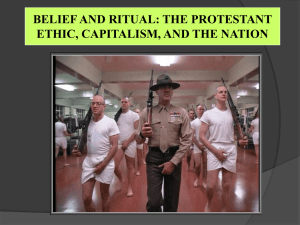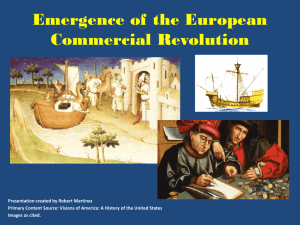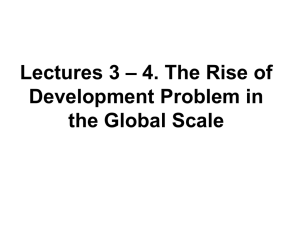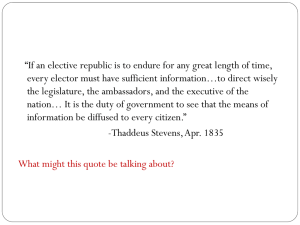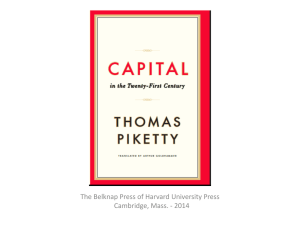Inequality and Instability - The Dallas Philosophers Forum
advertisement
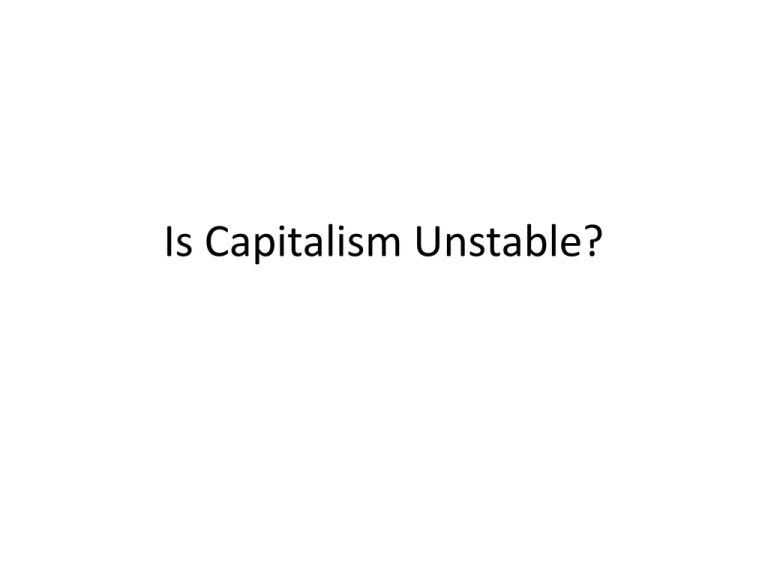
Is Capitalism Unstable? What is the Price of Inequality? • The gains at the top are far less than the loses at the bottom and middle. • Slower growth • Lower GDP • More instability • More Unemployment • Weakened Democracy • Diminished sense of fairness and justice • Questioning of our sense of identity Arguments Favoring Status Quo • There is an equality – efficiency tradeoff! • Inequality is the inevitable consequence of any incentive system adopted to make the economy work. • Any redistribution necessarily attenuates incentives. • What we have is equality of opportunity. • Any government interference will result in diminishing tax revenues thus hurting everyone. What is Capitalism? • Webster defined capitalism as “an economic system characterized by private or corporation ownership of capital goods, by investments that are determined by private decision rather than state control, and by prices, production, and the distribution of goods that are determined in a free market.” What is Capitalism? (from Wikipedia) • Capitalism is defined as a social and economic system where capital assets are mainly owned and controlled by private persons, where labor is purchased for money wages, capital gains accrue to private owners, and the price mechanism is utilized to allocate capital goods between uses. • The extent to which the price mechanism is used, the degree of competitiveness, and government intervention in markets distinguish exact forms of capitalism. What is Capitalism? (from Wikipedia) • There are different variations of capitalism which have different relationships to markets and the state. – In free-market and Laissez-faire forms of capitalism, markets are utilized most extensively with minimal or no regulation over the pricing mechanism. – In interventionist and mixed economies, markets continue to play a dominant role but are regulated to some extent by government in order to correct market failures, promote social welfare, conserve natural resources, and fund defense and public safety. – In state capitalist systems, markets are relied upon the least, with the state relying heavily on state-owned enterprises or indirect economic planning to accumulate capital. Ideal Capitalism • In this view, Property belongs to citizens, not to governments. People should be allowed to keep what they earn. • The profit motive should be allowed free reign. • Regulation and taxation, especially progressive taxation, are illegitimate government interventions and lead to a less efficient market place. • “Government is not the solution; government is the problem!” Traditional Capitalism Died (in the 1920’s and 1930’s) • Russia, China, and East Asia went to Communism. • Central Europe, Italy, Spain, and Japan went to Fascism. • U.S., Scandinavian countries, and British Empire went to the welfare state. • Many emerging countries remained underdeveloped with warlords and dictatorships. Assumption of Stable Equilibrium • Adam Smith, following Newton and Quesnay, – Assumed stable equilibria necessary to have a science. – But Smith knew that government had to be involved to guarantee continuance of capitalism. • Every Econ 101 Course. – Price is assumed to be stable at the equilibrium where supply = demand. Not permanently fixed; but for any given supply and demand there is one equilibrium price. – If not, things get messy and we don’t want to talk about that. • So non-stable or situations without equilibrium just didn’t get much attention or interest. • Dynamic Stochastic General Equilibrium models replaced other equilibrium models. Assumption of Stable Equilibrium • For Milton Friedman stability was a matter of keeping the Gov. & the Fed from interfering. – But then how do you explain the Great Depression. – The answer was an exogenous shock of mismanagement of the money supply. • Alan Greenspan thought the economic markets were stable and would automatically adjust. – After the recent melt down he acknowledged the error. • Almost every major contributor to macroeconomics knew that real economies are not stable. What is Stability? Diagram from Irrational Exuberance by Robert Shiller, 2005 What is Stability? Diagram from stockcharts.com 2011 So Instability is • The presence of any condition or process which drives some necessary aspect of the economy off a cliff into destruction or into subsidence from which it seems unable to recover. • Any perturbation which causes increasing fluctuations without limit. Australian Current Accounts ($A mill.) Current Account Debt (1980 – 2008) The Debt to GDP Ratio? • Ken Rogoff and Carmen Reinhart published an empirical study titled “Growth in a Time of Debt” in 2010. They found that there was a tipping point when debt reached 90% of GDP. At that point growth tended to become negative, i.e. – countries fall into recession. • However, Thomas Herndon, in a paper for his econometric class, discovered an error in the spreadsheet which cut out 5 relevant countries. Fixing the error changed the growth rate from -0.1 to +2.2% which is about the same as other countries and which totally eliminates the “tipping point.” • Thus a major argument for the austerity approach is eliminated. How the Multiplier Works Assuming Propensity to Spend = .8; the Multiplier = 5. If the Government gives me $100 I spend $80 for groceries. The store mgr. spends $54 for plumbing repairs. The Plumber spends $43.20 for shoes. Totals: I save $20 at the bank. She saves $16. He saves $10.80. $34.56… Etc. $8.64 $500 $100 Etc. • • • • “IMF Chief Economist, Olivier Blanchard and colleague Daniel Leigh, released a working paper that has been seen as an unofficial apology. The paper shows how fiscal multipliers were consistently and severely underestimated in many of the economic growth forecasts of 2010. The underestimation of these multipliers led to projections from economist’s models that also underestimated the potentially negative impacts of austerity measures.” The new research from the IMF’s chief economist shows that in 2010, most economists failed to see how adverse those austerity measures would be on the European economies that were struggling to get their fiscal house in order. Most forecasters, including those at the IMF, based their estimates on what fiscal multipliers had been in the past, causing them to underestimate the multipliers. Two years later, the Greek economy is still shrinking and unemployment is at 25 percent.” The fund’s Chief Economist acknowledged the mistake in his paper, finding that the average fiscal multiplier used was .5 when 1.5 was closer to the mark. A recent econometric analysis by economists Alan Auerbach and Yuriy Gorodnichenko found that fiscal multipliers in the United States fluctuate from near zero in normal times to nearly 2.5 during a recession. In other words, a $1 cut in government spending that would normally have little impact on economic output might result in as much as a $2.50 reduction in total economic output today Kevin Buchnall’s Synthesis of Classical and Keynesian Economics Price Index AD3 Boom time AD1 Depression SAS is the curved line AD2 LAS Real GDP Working Hypotheses • Capitalism generally involves somebody getting out more money than they put in (profit). So capitalism, if successful, is a money pump that increases the disparity between wealthy and poor (unless the poor have money pumps that move money from the rich). • Some of us have acquired very efficient money pumps. • Capitalist extraction by itself is unstable and leads to collapse. • Government, by its transfer payments, has prevented collapse so far. (Twice in the past 80 years we have been on the edge.) • What government does is critical to survival of the system! • This necessity is commonly misunderstood and threatened. Extractive Politics produce Extractive Economic Systems and vice versa • Extractive political systems exist for the benefit of a narrow elite, and create an extractive economic system. The masses cannot influence the political system, and have no incentives to exert themselves creating wealth that will be taken from them by the political elites. This produces a big gap between rich and poor and two kinds of failure: Collapse and the iron law of oligarchy. • History shapes this cycle. (e.g. Colonial extractionism) • Sustained economic growth requires innovation which involves creative destruction which threatens the dominant elite. • In extractive situations, there is likely to be competition for political power and therefore political & economic instability. Evidence for Extractionism from Well known Truisms • • • • The rich get richer and the poor get children. Money attracts money. He who has will be given a lot more. “The forces in a capitalist society, if left unchecked, tend to make the rich richer and the poor poorer.” Jawaharlal Nehru • It takes money to make money. Inclusive Politics produce Inclusive Economic Systems and vice versa • Inclusive political systems provide widely utilized incentives for people to acquire skills, work hard, save, invest, and innovate and thereby profit. This requires a strong central government that reflects the interests of many. This tends to produce a more egalitarian and wealthy society. • Inclusive economic institutions enforce property rights, create a level playing field, encourage investments in new technologies and education or training. Innovation and creative destruction are encouraged. • History shapes the institutions of nations. – The black death forced the collapse of the feudal serfdom in western Europe. – The growth of Parliamentarianism broadened participation in politics and economics. – English efforts to extract wealth from North America failed more egalitarian soc. • But this virtuous cycle is hard to start, rarely successful, and can be corrupted by the growth of extractionism. More on Extractionism • David Cay Johnston, Free Lunch: How the Wealthiest Americans enrich themselves at Government Expense (and stick you with the bill) • Chrystia Freeland, Plutocrats: The Rise of the New Global Super-Rich and the Fall of Everyone Else. Extraction in America • When sequestration affected the wealthy travelers, it was fixed. But cancer patients, the elderly and the poor do without. • The fight over 501(c) 4 organizations illustrates the political and economic clout of the wealthy. • Tax breaks for the wealthy and corporations. • There is a continuing battle over free ISP’s in United States. • No sales of cars in N. Carolina without brick & mortar stores. • Efforts to cut Soc. Sec., Medicare, Medicaid, etc. • Subsidies for rich corporations. • Over 45,000 well paid lobbyists in Washington. • The Paul Ryan Budget. From a 2005 study by Larry M. Bartels Current Issues • • • • • • Debt Finance Wealth Concentration Jobs (Employment) Consumption and Production Environment Finance • • • • • • Reckless provision of credit Creation of dubious financial instruments Collapse of housing and financial markets Reluctance of lenders to lend Reluctance of borrowers to borrow These affect the concentration of wealth and employment prospects. Changes in wages and productivity • Productivity has surged, but income and wages have stagnated for most Americans. If the median household income had kept pace with the economy since 1970, it would now be nearly $92,000, not $50,000. Wealth Concentration • Along with economic power so also political power is concentrated. • We have witnessed great growth in profits without growth in wages • Erosion of fair and inclusive market rules • Capture of government for benefit of the few • Extractionism (Exploitation and exclusion of the poor) • Manipulations of Democracy • Erosion of opportunities for ownership and employment Employment • Lower consumption means layoffs. • Leads to declining wages, skills, purchasing power. • This means lower consumption and therefore it impacts investment and production. • This is a vicious cycle (i.e. – Instability) The Triffin Dilemma • The use of a national currency (i.e. the U.S. dollar) as global reserve currency leads to a tension between national monetary policy and global monetary policy. This is reflected in fundamental imbalances in the balance of payments, specifically the current account: some goals require an overall flow of dollars out of the United States, while others require an overall flow of dollars into the United States. The Triffin Dilemma (source: IMF) • If the United States stopped running balance of payments deficits, the international community would lose its largest source of additions to reserves. The resulting shortage of liquidity could pull the world economy into a contractionary spiral, leading to instability. • If U.S. deficits continued, a steady stream of dollars would continue to fuel world economic growth. However, excessive U.S. deficits (dollar glut) would erode confidence in the value of the U.S. dollar. Without confidence in the dollar, it would no longer be accepted as the world's reserve currency. The fixed exchange rate system could break down, leading to instability. Mundell’s Trilemma • It is not possible to have monetary independence, free movement of capital, and stable currency exchange rates. • You must either let your currency float, or attempt to prevent currency from moving in or out of the country, or let someone else run your monetary policies. Recent Versions of Mundell’s Trilemma • Dani Rodrik’s version is that “democracy, national sovereignty, and global economic integration are mutually incompatible.” • Ashok Bardhan makes it a tettralemma. “It is difficult to see how tenuous co-habitation of these four – globalization, free market principles, democracy, and national policy independence – can survive in the present circumstances.” James Galbraith found weak correlations between political party and perceptions of equality • Those who perceive their world as roughly egalitarian tend to vote Republican. • Those who perceive it otherwise, tend to vote Democratic or not to vote at all. Galbraithian Results • But Republican policies increase inequality. • While Democratic policies increase equality. • These are negative feedback loops which tend to produce a stable division of the country right down the middle. More Galbraithian Results • Empirical studies show that Inequality in income leads to increased unemployment, which leads to increased inequality of income. • This is a vicious cycle leading to economic [and political] instability. • Galbraith’s book Inequality and Instability was published in 2012. But it is mostly a collection of articles previously published before 2008. Wilkinson and Pickett • In The Spirit Level, Wilkinson & Pickett chart data that show societies that are more equal are healthier, happier societies. • They show that the relevant variable is not absolute wealth or income, but variation (inequality) of income within a nation. • What gets worse when rich and poor are too far apart? Health, lifespan, illiteracy, infant mortality, homicides, imprisonment, teenage births, obesity, mental illness, UNICEF index of child wellbeing, social mobility, even such basic values as trust. • And what is damaged is not just the outcome for the poor, but for everyone including the rich. Death rates per 100,000 among working age men by social class of occupation. England & Wales Sweden 1000 800 600 400 200 0 Unskilled Professional FDI & Outsourc ing Waste Fraud & Abuse Offshore Bank Accounts Hedge Funds & Currency Spec Financial (Non-Home) Wealth (Source: E. N. Wolff@NYU) Financial (Non-Home) Wealth 1983 1989 1992 1995 1998 2001 2004 2007 2010 Top 1 percent Next 19 percent Bottom 80 percent 42.9% 46.9% 45.6% 47.2% 47.3% 39.7% 42.2% 42.7% 42.1% 48.4% 46.5% 46.7% 45.9% 43.6% 51.5% 50.3% 50.3% 53.5% 8.7% 6.6% 7.7% 7.0% 9.1% 8.7% 7.5% 7.0% 4.7% PEW Research: 2013


